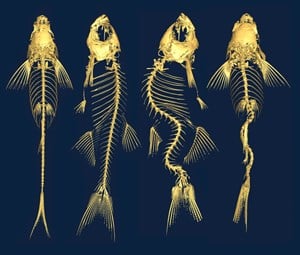Disrupted spinal fluid flow could cause scoliosis, new zebrafish study says
Summary:
New research suggests that idiopathic scoliosis, a debilitating disease characterized by a three-dimensional curvature of the spine, could be caused by irregularities in the flow of fluid in the spinal column.

New research suggests that idiopathic scoliosis, a debilitating disease characterized by a three-dimensional curvature of the spine, could be caused by irregularities in the flow of fluid in the spinal column.
Using zebrafish, the team led by The Hospital for Sick Children (SickKids) and Princeton University found that zebrafish with a mutation in the gene Ptk7 developed spinal curvatures that are similar to those in human patients with idiopathic scoliosis. This gene affects how cilia, the tiny hair-like projections that line the spinal canal, beat to move fluid. More importantly, the team uncovered that when cilia function and cerebrospinal fluid flow was restored, the zebrafish either did not develop the disease in the first place or it halted the disease progression. The study is published in the June 9 online edition of Science.
Despite being the most common musculoskeletal disease, occurring in about three per cent of all children, the underlying causes as to why people develop this spinal deformity have been completely unknown. These results are the first to shed light on the role of motile cilia and cerebrospinal fluid dynamics in spine development and may be the elusive biological link as to why humans develop idiopathic scoliosis.
“Traditionally, theories regarding the biology behind idiopathic scoliosis have revolved around defects in the bone, cartilage or neuromuscular activity. The finding that defects in cerebrospinal fluid flow may be contributing to scoliosis came as a surprise. It is not a theory that had been put out there previously,” says the study’s Principal Investigator, Dr. Brian Ciruna, Senior Scientist and Head of Developmental & Stem Cell Biology at SickKids, and Associate Professor in Molecular Genetics at the University of Toronto.
He adds that if the findings are translatable to humans, the study suggests a non-surgical approach to treating the condition.
The research was supported by funding from the Canada Research Chairs program, National Institute of Child Health and Development, the Canadian Institutes of Health Research, March of Dimes Foundation and SickKids Foundation.

